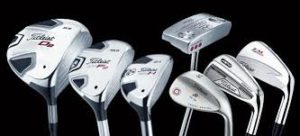Choose your clubs wisely
It is common place to compare and try to copy others and this of course happens in golf. People take videos of their swings and try to compare them to tour players to copy their swings, although this can be useful in the right context the number of relevant differences between the 2 players are often overlooked. We clearly are different from one another so why should our swings be the same. A similar thing can be said for the clubs we are carrying in our bag. In my experience (although there is an improvement) a lot of golfers have just gone to shops and put a standard configuration of 3 woods, 9 irons and a putter in the bag. Sometimes they have added the hybrid as they have been told it is good for getting the ball out of the rough. Our games can be completely different from one another. This can range from some being very accurate but not very long to others who may be directionally challenged. Some may struggle in the short game area or have difficulties hitting long irons. These characteristics should not be looked at as weaknesses but as traits that should steer us towards having the right set make up to help us get the best out of our game. For example some tour golfers may use drivers with 8 degrees of loft whilst others can be 12 degrees or more. One is no better than the other unless it is put with the individual player’s flight characteristic. We are not all the same!
If we are playing in any type of competition the rules of golf allow us to carry up to 14 clubs. So the first point here is make sure you have 14 clubs that suit your game. Don’t have clubs in the bag that you never use. One of the more common situations is a number of club golfers have added a 60 degree lob wedge to their set and have had poor results with it and therefore never use it but they still leave it in the bag. When it comes to your wedges consider a few of the following points.
If your chipping method tends to scoop the ball up (adds loft to the club) you probably won’t get much value from a 60 degree wedge think about going to a 58 or 56 degree.
If you have a sand wedge that is part of a set of irons (generic) find out what loft is on the face and how much bounce the sole has. Quite often the sand wedges in some sets can be as low as 53 degrees. Sole bounce and shape is important to the individual style so if you have a tendency to hit the ball with deep divots then generally a wedge with a lot of bounce 12 to 14 degrees can be advantageous.
Club lofts over the years have generally got stronger so a modern pitching wedge is nearly as strong as some 8 irons of past years. This really means that if you have a standard PW and a sand or lob wedge at 55 degrees or higher you need a gap wedge in your bag.
Some golfers may find that carrying 3 wedges (PW-48, GW-52/54, SW-56/58) is the ideal matrix for them leaving room to consider other options with the rest of the set while others will find 4 wedges (PW -46/48, GW-50/52, SW-54/56 LW-58/62) suit their game better. We are not all the same!
Another area of set make up to consider is long irons and hybrids. Because of the de-lofting of irons by manufactures over the years 3 and 4 irons have become a little more redundant for a lot of golfers and yet they tend to still get left in the bag even though they are not used. A few points to consider.
Even though hybrids are often numbered they don’t necessarily correspond to the equivalent in an iron for example if the hybrid has the number 4 on the base it is likely to be longer in length than a typical 4 iron. Also the loft is likely to be different and the natural design of hybrid heads means the centre of gravity is different and in simple terms this means it will affect the balls flight differently than an iron. Bottom line here is try before you buy and work out how far you want it to go and what flight works with these clubs.
For some players who do not generate a lot of spin or club-head speed it might be worth looking at lofted fairway woods instead. It is definitely worth having a fairway wood with 24/26 degrees of loft (most people would refer to this club as a 7 wood) if you do not get much height and distance from long irons and hybrids.
The 3 wood is often put in the bag but I think for some they would be better off with a 4/5 wood 6/7 wood combination. What I mean by this is that a standard 3 wood is 15 degrees so having a combination of fairway clubs that are between 17 and 24 degrees would be more useful for some and they will find that the slightly higher lofted club will go further than the 15 degree club. There is also another side to this where it may be useful for some golfers to carry a strong 3 wood (12/13 degrees) as this may be used as a slightly more accurate driver when needed. We are not all the same work out what suits you.
Driver fitting is more common now and I think it is fair to say that a lot of golfers are exploring this avenue with this club however it is worth thinking about the rest of your set and giving some thought to your game characteristics. Make sure you are not carrying around clubs that you don’t use, if so replace it with something useful. Make sure you have a good idea about how far you hit each club and if you have too many club selections that hit the ball too similar distances think about changing the set make up to give you better gapping between each club. Get your wedge matrix right for your game it is such an important area when it comes to scoring. There are no rules when it comes to how you make up the 14 clubs in your bag so make it right for your game, remember “we are not all the same”!
Paul Thompson has been the Fellow PGA Professional at Powerscourt Golf Club in Wicklow since 1995. In addition to providing coaching on-site he also is a coach with The Golfing Union of Ireland. Appointments with Paul can be booked via Powerscourt Golf Club Reception: Tel (01) 204 6033 or the Golf Shop Tel (01) 204 6031. Read more about lessons from Paul Thompson by visiting the Powerscourt Golf Club Website.



